White slave ownership nonexclusive
23 Sunday Jun 2019
Written by dennisghurst in Attributes, Consequences, Origins
Tags
Barack Obama, Billy Graham, Christ, Christianity, Conservatism, Constitutional Republic, Democrat Party, Donald Trump, Everlasting, Experience, Family, Freedom, Genealogy, God, Jesus Christ, Lessons, Let Freedom Ring, Liberty, Life, Posterity, Roe vs Wade, Self-Preservation, Teaching, United States, Wisdom
Share it

History is the exposition of Truth. The more Truth isn’t taught in schools, the more mendacious it becomes. ~ DGH, student of history
In light of the recent spurious congressional hearings on the topic of slavery, plus all the rapacious yowls for reparational satisfaction, it behooves all right-minded patriots to approach the topic with serious intent, particularly as it relates to who owned whom, what, when, why, and the outcome.
Much of what yours truly learned about the slave trade was my sojourn in Jamaica in the mid-60s when I was on the teaching staff courtesy of Britain’s ‘Voluntary Service Overseas’ (still in operation, btw) at the Kingston Technical High School where I got to know Marcus Garvey Jr., and the exploits of his father in the ‘Back to Africa’ movement of the 1920s – 30s.
One of the lesser known aspects of the history of slavery is how many and how often non-whites owned and traded slaves early in America’s founding. Free black slave holders could be found at one time or another “in each of the thirteen original states and later in every state that countenanced slavery,” historian R. Halliburton Jr. observed. The stark reality that black people bought and sold other black people raises ‘vexing questions’ for 21st-century Americans like African-American writer Henry Louis Gates Jr., who asserts that it betrays class divisions that have always existed within the black community.
For others, it’s an available and convenient excuse to deflect the shared blame away from white people for the institution of slavery in America.
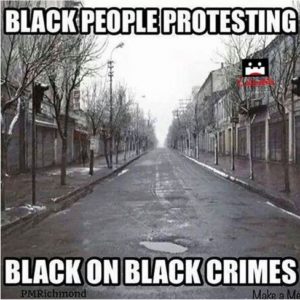
Slavery was common for thousands of years / White people ended legal chattel slavery.
How ‘common’ slavery has been, and what the specific nature of that slavery was, has varied according to specific periods of time and place.
In one respect for instance, it can be rather self-serving to claim that ‘white people’ ended legal chattel slavery in the United States (much less ended chattel slavery, period), given that the overwhelming majority of blacks in the U.S. weren’t allowed to vote, run for political office, and, in every other way conceivable, were excluded from institutional power.
Moreover, even as some white people were laboring to put an end to slavery, many others were fighting to preserve it.
Slavery was eliminated in America via the efforts of people of various ethnicities, including Caucasians, who took up the banner of the abolitionist movement with a passion. The names of the white leaders of that movement tend to be better known than those of the black leaders, among whom were David Walker, Frederick Douglass, Dred Scott, Harriet Tubman, Sojourner Truth, Nat Turner, and many others beyond remembrance.
Reality avers that when Congress finally passed (and the states ratified) the 13th Amendment in 1865, it was the culmination of many years toil by a multi-racial movement.
Most slaves brought to America from Africa were purchased from black slave owners.
Historian Steven Mintz describes the situation more accurately in the introduction to his book African-American Voices: A Documentary Reader, 1619-1877:
‘Apologists for the African slave trade long argued that European traders did not enslave anyone: they simply purchased Africans who had already been enslaved and who otherwise would have been put to death. Thus, apologists claimed, the slave trade actually saved lives. Such claims represent a gross distortion of the facts. Some independent slave merchants did in fact stage raids on unprotected African villages and kidnap and enslave Africans. Most professional slave traders, however, set up bases along the west African coast where they purchased slaves from Africans in exchange for firearms and other goods. Before the end of the seventeenth century, England, France, Denmark, Holland, and Portugal had all established slave trading posts on the west African coast’.
‘Yet to simply say that Europeans purchased people who had already been enslaved seriously distorts historical reality. While there had been a slave trade within Africa prior to the arrival of Europeans, the massive European demand for slaves and the introduction of firearms radically transformed west and central African society. A growing number of Africans were enslaved for petty debts or minor criminal or religious offenses or following unprovoked raids on unprotected villages. An increasing number of religious wars broke out with the goal of capturing slaves. European weapons made it easier to capture slaves’. [end]
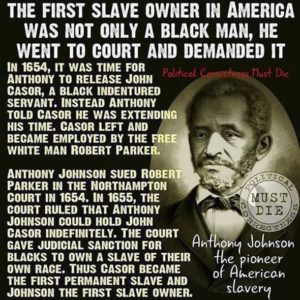
The first legal slave owner in American history was a black tobacco farmer named Anthony Johnson.
A former indentured servant himself, Anthony Johnson was a “free negro” who owned a 250-acre farm in Virginia during the 1650s, with five indentured servants under contract to him. One of them, a black man named John Casor, claimed that his term of service had expired years earlier and Johnson was holding him illegally. In 1654, a civil court found that Johnson in fact owned Casor’s services for life, an outcome historian R. Halliburton Jr. calls “one of the first known legal sanctions of slavery – other than as a punishment for crime.”
Many black slaves were allowed to hold jobs, own businesses, and own real estate.
There were exceptions, but generally speaking – especially after 1750, by which time slave codes had been entered into the law books in most of the American colonies – black slaves were not legally permitted to own property or businesses. From the Oxford Companion to American Law (2002): ‘Under these early codes, slaves had virtually no legal rights. In most areas they could be executed for crimes that were not capital offenses for whites. Their testimony was restricted in legal cases and could not be used either for or against whites. Trials of slaves were usually by special courts. Slaves could not own property, move about without consent of their owners, or legally marry’.
In 1830 there were 3,775 free black people who owned 12,760 black slaves.
According again, to historian R. Halliburton Jr, there was black-on-black slavery in America, resulting in “approximately 319,599 free blacks in the United States in 1830. Approximately 13.7 per cent of the total black population was free. A significant number of these free blacks were the owners of slaves. The census of 1830 lists 3,775 free Negroes who owned a total of 12,760 slaves.”
South Carolina’s 1860 census lists 171 black slaveholders, including plantation owner William Ellison, the largest owner in the state.
William Ellison was a very wealthy South Carolina black plantation owner and cotton gin manufacturer. According to the 1860 census (in which his surname was listed as “Ellerson”), he owned 63 black slaves, making him the largest of the 171 black slaveholders in South Carolina.
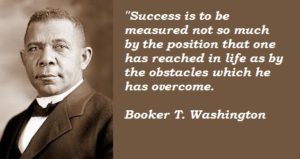
American Indians owned thousands of black slaves.
Historian Tiya Miles provided this snapshot of the Native American ownership of black slaves at the turn of the 19th century for Slate magazine in January 2016:
‘Miles places the number of enslaved people held by Cherokees at around 600 at the start of the 19th century and around 1,500 at the time of westward removal in 1838-9. (Creeks, Choctaws, and Chickasaws, she said, held around 3,500 slaves, across the three nations, as the 19th century began.) “Slavery inched its way slowly into Cherokee life,” Miles told me. “When a white man moved into a Native location, usually to work as a trader or as an Indian agent, he would own [African] slaves.” If such a person also had a child with a Native woman, as was not uncommon, the half-European, half-Native child would inherit the enslaved people (and their children) under white law, as well as the right to use tribal lands under tribal law. This combination put such people in a position to expand their wealth, eventually operating large farms and plantations’. [end]
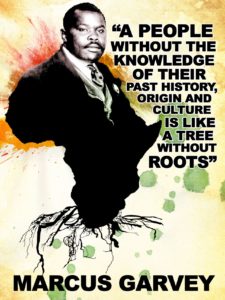
Postscript: Marcus Garvey and his Back to Africa movement.
In the early twentieth century, Marcus Garvey and his movement, the Universal Negro Improvement Association (UNIA), founded in his native Jamaica in 1914, boosted emigration sentiment. Three years later, Garvey immigrated to New York and set up headquarters in Harlem.
Garvey’s version of Black Nationalism argued that African Americans’ quest for social equality was a delusion. They were fated to be a permanent minority who could never assimilate because white Americans would never let them. African Americans, therefore, could not improve their condition or gain autonomy in the United States. Only in Africa was self-emancipation possible.
Although his efforts at sending African Americans back to Africa ultimately failed, Garvey’s influence remained strong and inspired some to migrate, on their own, to the land of their ancestors.
To Repeat: History is the exposition of Truth. The more Truth isn’t taught in schools, the more mendacious it becomes. ~ DGH, student of history
********************
See also Black slave ownership always forgotten
Historian R. Halliburton Jr.: Free Black owners of Slaves
Don’t miss Marcus Garvey Sr., Back to Africa Movement
Steven Mintz: African-American Voices: Documentary Reader
Michael Harriot: Why We Never Talk about Black on Black Crime
And don’t miss The Horrible fate of John Casor black on black slave
Plus Patricia L. Dickson, Slavery reparations argument built on false premise
********************
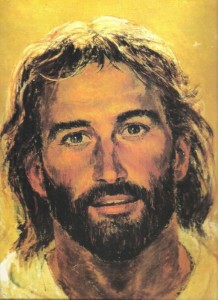
Soli Deo Gloria!

 Link To DennisGHurst.com
Link To DennisGHurst.com



One Comment